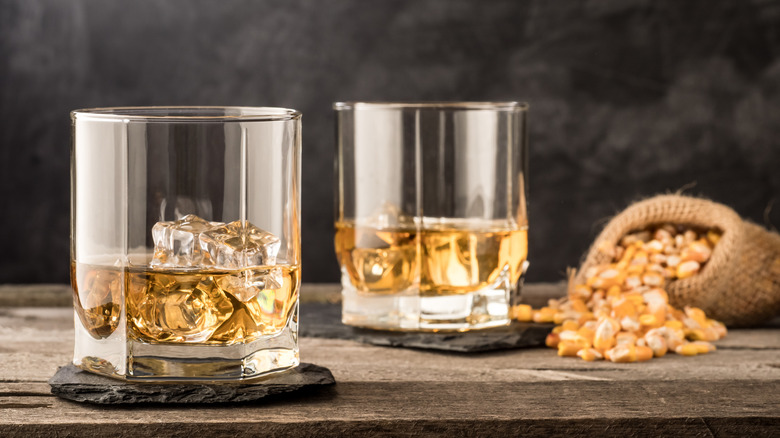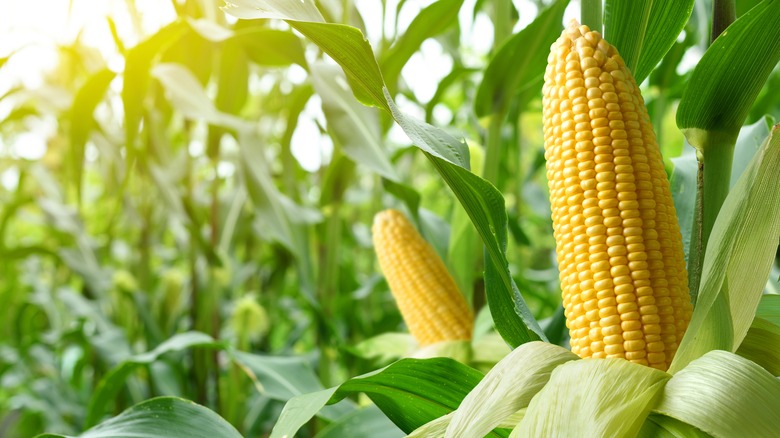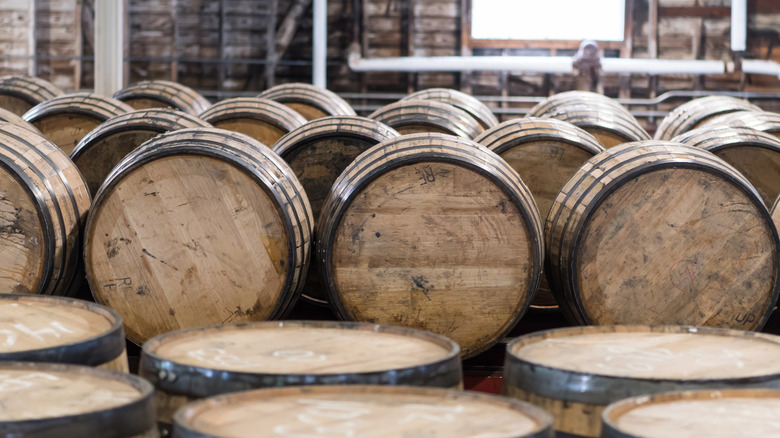What Is High Corn Bourbon And How Is It Different From Corn Whiskey?
Yes, bourbon is whiskey. We all know that now, thanks to ever-flowing information on our smartphones, watches, and tablets. A quick search confirms that bourbon is a firm member of the whiskey family, but it doesn't always go both ways. It rarely does, especially when it comes to high-corn bourbon and the similar-sounding but very distinct corn whiskey.
Let's face it: Bourbon is the "cultural elite" of American spirits, defined by its exclusive nature, often high prices, and rigid ingredient and process requirements. Even if the same recipe gets replicated outside U.S. borders, it can never bear the bourbon name. It's strictly an American creation, receiving an Act of Congress designation as "The Official Spirit of America" in 1964.
The bourbon industry plans to keep that "untouchable" mystique, made easier by the string of non-negotiable rules attached to the production. Since bourbon must contain at least 51% corn, that's the first element to narrow the playing field between standard whiskeys and bourbons. Then there are the separate categories of "corn whiskey" and "high corn bourbon."
High corn bourbon has an aging requirement of two years
Bourbons and corn whiskeys each contain corn in their mash bills, which are a distiller's unique combination and percentage of corn, rye, wheat, and malted barley. For a designated "high corn" bourbon, the required percentage of corn rises from 51% to 80%, which equates to the same amount in a corn whiskey, notes Distiller. With that equal playing field established, it would seem the two were interchangeable — but it doesn't work that way.
Several strictly defined designation policies govern how bourbon, including high corn versions, must be produced. Though some apply to corn whiskeys as well, others specifically and deliberately delineate the two. Bourbon must be made in America — no exceptions, whereas corn whiskey can come from anywhere, as long as it meets U.S. standards such as the 80% corn content. But from there, the distinctions diverge. It mostly comes down to the barrels and how long the whiskeys remain inside them.
Bourbons have mandatory storage requirements for barrel materials and aging times, which differ from corn whiskeys. Any bourbon must be stored in brand-new charred oak barrels, and they're obliged to remain there for at least two years. It's quite the opposite for corn whiskeys.
Corn whiskey restrictions protect bourbon territory
In comparison to high corn bourbons, standard corn whiskeys have no aging requirements. The only exception is if it's labeled as a "straight corn whiskey," in which case it gets the same two-year aging as bourbons. Even more crucially defining, the Alcohol and Tobacco Tax & Trade Bureau (TTB) states that any oak-based storage of corn whiskey must take place in used or uncharred vessels instead of new ones, specifically preventing corn whiskey from being classified as any type of bourbon.
And forget about externally adding that distinctive charred-wood bourbon taste to corn whiskey through oak chips; the TTB says that's a no-go. Finally, corn whiskeys can't be blended with any other spirit that's been in contact with charred wood. In fact, any bourbon, including high corn versions, by law has no added flavors or colors — nothing but water if needed to reach the maximum proof restriction.
Apart from federal requirements, a gift from Mother Nature impacts bourbon differently than other whiskeys, including high-corn ones. Primarily, it's the water, according to Kentucky Tourism. Since 95% of all bourbon comes from Kentucky, it benefits from limestone reserves through which the state's water flows, thereby naturally filtering out any harsh-tasting iron or undesirable minerals.


